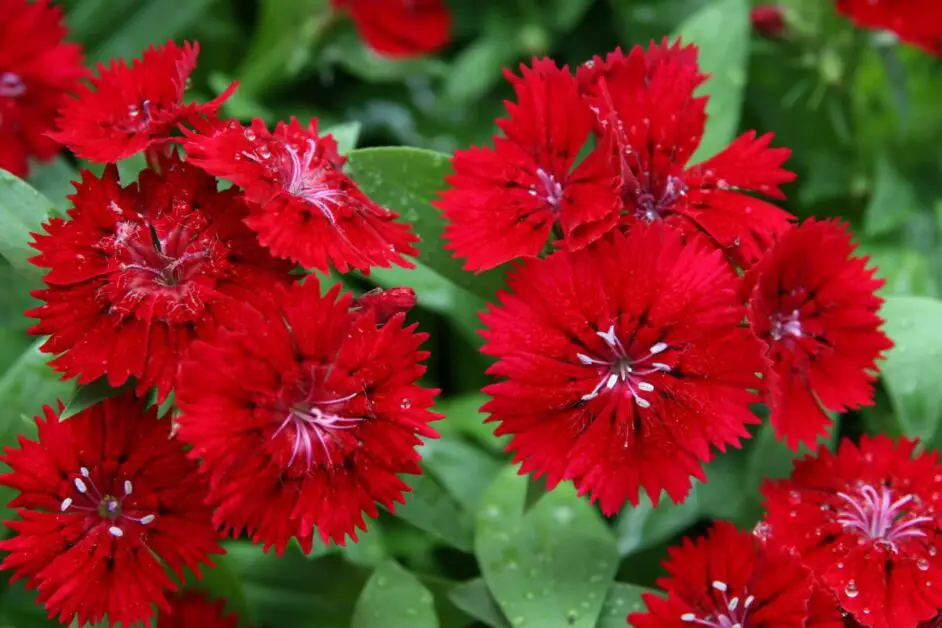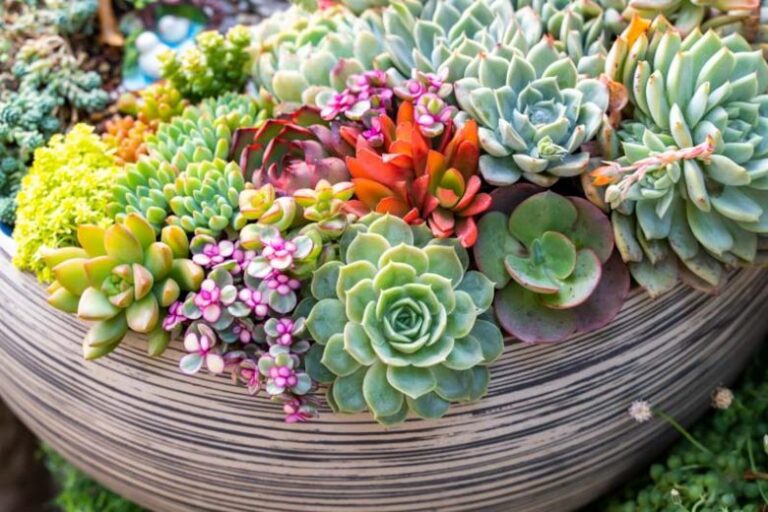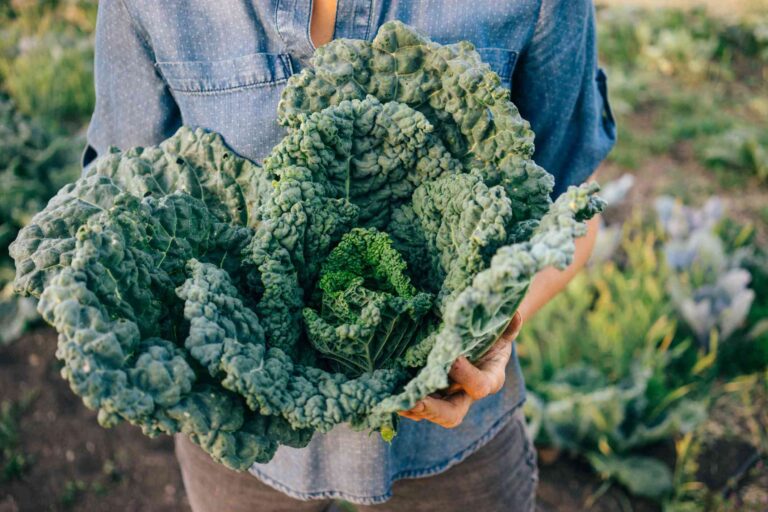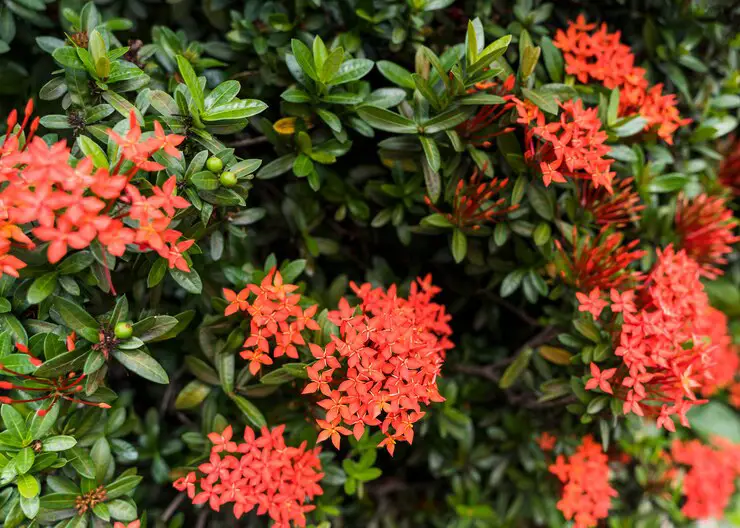Dianthus: Easy-Growing Perennials for Colorful Blooms
Are you looking to add a splash of vibrant color and easy-care beauty to your garden? Enter the world of Dianthus, the charming perennials known for their colorful blooms and delightful fragrance. Did you know that Dianthus flowers come in a variety of hues, from soft pastels to bold brights, making them a versatile choice for any garden? These easy-growing plants are not only a visual treat but also a joy to cultivate. Join us on a floral adventure as we explore the wonders of Dianthus, sharing expert tips and insights on how to grow these lovely perennials successfully.
Get ready to enhance your outdoor space with the colorful blooms and sweet scents of Dianthus. Let’s plant, grow, and enjoy the beauty together!
Table of Contents
Choosing the Right Varieties for Your Climate
Choosing the right varieties of dianthus for your climate is essential for ensuring the success and longevity of your garden. Different dianthus varieties thrive in different climates, so it is important to select varieties that are well-suited to your specific environment.

- Temperature and Climate:
- Cold-Hardy Varieties:
- Cheddar Pink (Dianthus gratianopolitanus): These dianthus varieties can withstand freezing temperatures and are suitable for colder climates with winter frost.
- Heat-Tolerant Varieties:
- Maiden Pink (Dianthus deltoides): These dianthus varieties thrive in warmer climates with hot summers.
- Cold-Hardy Varieties:
- Rainfall and Soil Moisture:
- Moisture-Loving Varieties:
- Sweet William (Dianthus barbatus): These dianthus varieties prefer moist soil and can tolerate slightly wet conditions. Ideal for regions with higher rainfall.
- Drought-Tolerant Varieties:
- Cottage Pink (Dianthus plumarius): These dianthus varieties thrive in drier climates with lower rainfall.
- Moisture-Loving Varieties:
- Soil Type and pH:
- Preferred Soil Conditions:
- Dianthus generally prefers well-draining soil.
- Optimal pH range: 6.5 to 7.5 (slightly alkaline).
- Adaptability:
- Some dianthus varieties can tolerate a wider range of soil conditions.
- Preferred Soil Conditions:
By selecting dianthus varieties that are well-suited to your climate, you can ensure that your garden thrives and produces beautiful blooms year after year. Take the time to research and choose varieties that are known to perform well in your region, and you will be rewarded with a vibrant and healthy dianthus garden.
Understanding Dianthus Growing Requirements
Dianthus, also known as carnations or pinks, are popular flowering plants known for their vibrant and beautiful blooms. To ensure successful growth and blooming, it is important to understand the specific requirements of these plants.

The following table explains about the Dianthus growing requirements:
| Growing Parameter | Optimal Range |
|---|---|
| 1. Sunlight | 6-8 hours/day |
| 2. Temperature | 60-70°F (15-21°C) |
| 3. Soil pH | 6.0-7.5 |
| 4. Soil Moisture | Moderate, well-drained |
| 5. Watering Frequency | Once or twice per week |
| 6. Fertilization | Monthly, balanced fertilizer |
| 7. Spacing | 6-12 inches apart |
| 8. Pruning Frequency | Weekly to maintain shape |
Understanding these basic growing requirements will set you on the path to successful dianthus cultivation. By providing the appropriate soil conditions, ample sunlight, and proper watering techniques, you can create a favorable environment for these stunning plants to thrive and grace your garden with their vibrant colors.
Preparing the Soil for Dianthus Planting
Preparing the soil is an essential step in ensuring successful growth and development of dianthus plants. Before planting, it is crucial to assess the quality of the soil and make any necessary amendments to create a favorable environment for these delicate flowers.

- Soil Drainage:
- Well-Draining Soil: Dianthus plants thrive in well-draining soil.
- Risk of Root Rot: Excessive moisture can lead to root rot and other diseases.
- Enhance Drainage: Incorporate organic matter (compost or aged manure) into the soil to improve drainage.
- Nutrient Boost: Organic matter also provides essential nutrients for healthy growth.
- Soil pH:
- Preferred pH Range: Dianthus prefers a slightly alkaline environment.
- pH Range: Aim for a pH between 6.5 and 7.5.
- Adjusting pH:
- Too Acidic: Add lime to raise the pH level.
- Too Alkaline: Use sulfur or peat moss to lower the pH.
By taking the time to prepare the soil properly, you are setting the stage for successful dianthus planting. This proactive approach not only ensures better growth and blooming but also minimizes the risk of pests and diseases. So, before you start planting your dianthus, invest some effort in preparing the soil – your plants will thank you with vigorous growth and beautiful blooms.
Planting Dianthus: Step-by-Step Guide
When it comes to planting dianthus, it is essential to follow a step-by-step guide to ensure successful growth.
- Select Suitable Location: Choose a spot with at least six hours of direct sunlight daily for planting dianthus. Ensure the area is free from weeds, rocks, and debris.
- Prepare Planting Area: Loosen the soil with a garden fork or tiller and incorporate organic matter like compost or well-rotted manure to improve fertility and drainage. Perform a soil test to determine pH level and adjust if needed (preferably pH 6.0 to 7.0).
- Planting Process: Dig a hole slightly larger and deeper than the dianthus rootball. Carefully remove the plant from its container, preserving the roots. Place the plant in the hole, ensuring the top of the rootball is level with the soil surface. Backfill with soil and gently firm around the roots.
- Watering: After planting, thoroughly water the dianthus to settle the soil and remove air pockets. Provide regular watering, especially during dry periods, to maintain even moisture levels. Avoid overwatering to prevent root rot.
Planting dianthus is a simple yet crucial step in establishing a thriving garden. By following these step-by-step guidelines and providing the necessary care, you can enjoy the beauty and fragrance of these delightful flowers in your garden.
Proper Watering Techniques for Dianthus
To ensure the optimal growth and health of your dianthus plants, proper watering techniques are essential. Understanding the water requirements of dianthus will help maintain the right balance of moisture in the soil, preventing issues like root rot and wilting. Here are some important tips to keep in mind when watering your dianthus:
- Avoid Overwatering:
- Dianthus prefers moderately moist soil, not waterlogged conditions.
- Overwatering can lead to root damage and fungal diseases.
- Check Soil Moisture:
- Insert your finger into the soil up to the first knuckle.
- If it feels dry, it’s time to water.
- Effective Watering:
- Direct water to the base of the plant, avoiding foliage.
- Water early in the morning to allow leaves to dry quickly and reduce disease risk.
- Established Dianthus:
- Practice deep and infrequent watering.
- Encourages healthy root growth and drought tolerance.
In conclusion, proper watering techniques are essential for the successful cultivation of dianthus. By understanding and adhering to the watering needs of these plants, you can ensure their vigor, beauty, and overall health. Remember to strike the right balance between moisture and the avoidance of excess water, thus promoting the longevity and vitality of your dianthus plants.
Fertilizing Dianthus: Dos and Don’ts
Dianthus is a beautiful and versatile plant that can add a pop of color to any garden. Like any plant, it requires proper fertilization to ensure optimal growth and vibrant blooms. However, there are dos and don’ts when it comes to fertilizing dianthus that every gardener should be aware of.
| Dos | Don’ts |
|---|---|
| 1. Use Balanced Fertilizer: Choose a balanced, all-purpose fertilizer with equal N-P-K (nitrogen, phosphorus, and potassium) ratios. | 1. Avoid Over-Fertilizing: Excessive fertilization can harm dianthus. Follow recommended application rates. |
| 2. Apply in Spring: Fertilize dianthus in early spring when new growth emerges. | 2. Don’t Fertilize During Dormancy: Avoid fertilizing during winter dormancy. |
| 3. Water Before Fertilizing: Water the soil thoroughly before applying fertilizer. | 3. Don’t Apply Near Stems: Keep fertilizer away from the base of the plant to prevent root burn. |
| 4. Follow Package Instructions: Read and follow the fertilizer package instructions for proper application. | 4. Don’t Use High Nitrogen: High nitrogen levels can lead to excessive foliage growth and fewer blooms. |
| 5. Side-Dress Application: Apply fertilizer around the drip line of the plant, not directly on the stem. | 5. Don’t Fertilize Wet Leaves: Wet leaves can absorb excess nutrients and cause damage. |
| 6. Monitor Plant Response: Observe plant health and adjust fertilization as needed. | 6. Don’t Fertilize Sick Plants: Fertilizing sick or stressed plants can worsen their condition. |
By following these dos and don’ts of fertilizing dianthus, you can ensure healthy growth and vibrant blooms all season long. Remember to choose a balanced fertilizer and apply it during the plant’s active growing season. Avoid over-fertilization and refrain from fertilizing during dormancy. With proper fertilization, your dianthus will thrive and become the centerpiece of your garden.
Pruning Dianthus for Optimal Growth
To ensure optimal growth and abundant blooms, it is important to properly prune your dianthus plants. Pruning helps maintain the shape and size of the plant, promotes air circulation, and encourages the development of new growth. It is recommended to prune dianthus plants in early spring, just as new growth begins to emerge.

- Remove Dead or Damaged Growth: Begin pruning dianthus by eliminating any dead or damaged stems and leaves. This enhances the plant’s appearance and prevents disease spread. Use clean, sharp pruning shears for precise cuts to avoid jagged edges that can invite pathogens.
- Selective Pruning: Trim weak, straggly, or overcrowded stems or branches to improve air circulation and promote plant health. Make cuts just above a healthy leaf node or lateral shoot to encourage new growth.
- Regular Deadheading: Deadhead faded blooms regularly to stimulate continued flower production and prevent energy wastage on seed production. Trim stems back to healthy leaf nodes to encourage new blooms and maintain the plant’s vitality.
By following these pruning techniques, you can help your dianthus plants thrive and achieve their full potential. However, it is important to note that different dianthus varieties may have specific pruning requirements, so it’s always a good idea to consult specific care instructions for the particular variety you are growing.
As someone who has used the Fiskars Bypass Pruning Shears extensively, I can attest to their effectiveness in tackling various pruning tasks in the garden. These shears effortlessly slice through branches, providing clean and precise cuts, which promote plant health and growth. The ergonomic design ensures a comfortable grip, reducing strain on the hands and wrists during prolonged use. Moreover, the lightweight construction makes it easy to maneuver the shears, even when working in tight or awkward spaces.
However, over time, I noticed that the blades tend to dull, requiring frequent sharpening for optimal cutting performance. Additionally, the locking mechanism occasionally slips, which can be inconvenient and potentially hazardous. Despite these minor drawbacks, the Fiskars Bypass Pruning Shears remain a reliable and indispensable tool for any gardening enthusiast.
✅ Comfortable Grip: The ergonomic design of the handles provides a comfortable grip, reducing hand fatigue during extended use.
✅ Lightweight: These pruning shears are lightweight, making them easy to maneuver and reducing strain on the user’s hands and wrists.
✅ Durable Construction: Made with high-quality materials, including hardened steel blades and a sturdy handle, these shears are built to last and withstand regular use.
✅ Versatile: Suitable for a variety of pruning tasks, from trimming flowers and shrubs to cutting back small branches, making them a versatile tool for gardeners.
❌ Locking Mechanism: Some users have reported issues with the locking mechanism, finding it difficult to engage or disengage, which can be inconvenient during use.
❌ Handle Size: While the handles are comfortable to grip, some users with larger hands may find them a bit small, leading to potential discomfort during prolonged use.
❌ Maintenance Required: Like any cutting tool, these shears require regular maintenance, including sharpening the blades and oiling the pivot point, to ensure optimal performance and longevity.
❌ Price: While the Fiskars pruning shears offer excellent quality and performance, they may be considered a bit pricey compared to other options on the market.
Protecting Dianthus from Pests and Diseases
Dianthus, with their vibrant blooms and delicate fragrance, are a joy to have in any garden. However, like any plant, they can fall victim to pests and diseases if not properly protected. By taking preemptive measures, you can safeguard your dianthus from potential threats and ensure their healthy growth.
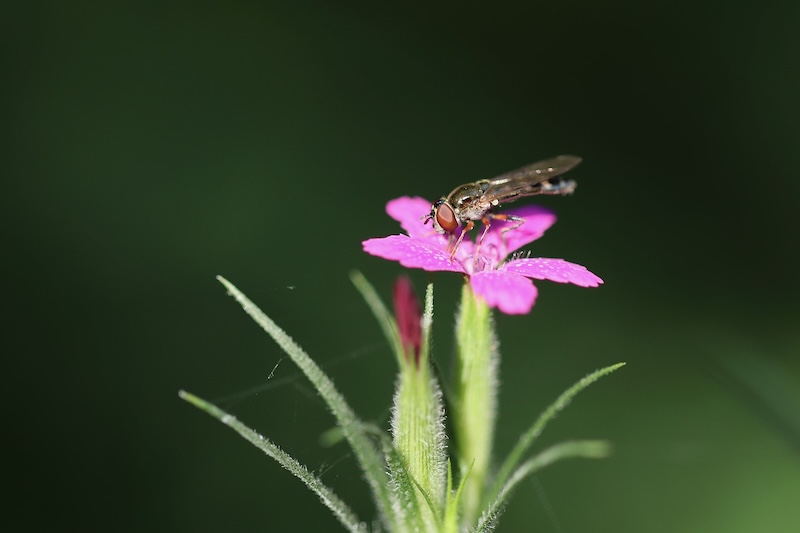
Pests:
- Aphids:
- Do: Regularly inspect your dianthus for aphids.
- Do: Promptly remove affected leaves or stems.
- Do: Introduce natural predators like ladybugs.
- Don’t: Ignore aphid infestations; they can harm your plants.
- Spider Mites:
- Do: Maintain adequate humidity levels around dianthus.
- Do: Regularly mist leaves or place a water tray nearby.
- Do: Consider introducing predatory mites (e.g., Phytoseiulus or Amblyseius).
- Don’t: Allow dry conditions; spider mites thrive in such environments.
Diseases:
- Gray Mold (Botrytis cinerea):
- Do: Ensure proper air circulation by spacing dianthus adequately.
- Do: Avoid overwatering and watering from above.
- Do: Promptly remove and dispose of infected parts.
- Don’t: Let gray mold spread unchecked.
By following these preventive measures and keeping a watchful eye on your dianthus, you can effectively protect them from common pests and diseases. With proper care, your dianthus will continue to flourish, providing you with beauty and fragrance throughout the growing season. Stay tuned to our next section to learn more about dividing and propagating dianthus to expand your collection.
Dividing and Propagating Dianthus
Dividing and propagating dianthus are essential techniques for maintaining the health and vigor of these beautiful flowering plants.

- Timing for Division: Divide dianthus plants during early spring or fall, avoiding times of active blooming.
- Dividing Process: Carefully dig up the entire plant, shaking off excess soil to expose roots. Use a sharp, clean gardening tool to divide the plant into smaller sections, ensuring each section has healthy stems and roots.
- Replanting Divisions: Replant divided sections in well-draining soil, spacing them adequately for proper growth. Provide sufficient water and care to promote strong root development.
- Propagation via Stem Cuttings: Select a healthy stem approximately 4-6 inches long for propagation. Make a clean cut just below a leaf node and dip the cut end in rooting hormone powder to stimulate root growth.
- Planting Stem Cuttings: Plant the cutting in a well-draining peat-based soil mix and cover with a plastic bag or dome to create a humid environment. Place in bright, indirect sunlight and maintain consistent moisture levels until roots develop.
By dividing and propagating dianthus, gardening enthusiasts can not only expand their garden’s dianthus collection but also maintain the vitality of their existing plants. These simple techniques provide a means to propagate and rejuvenate dianthus while ensuring a vibrant and bountiful display of these magnificent flowers.
The Miracle-Gro peat-based soil mix is a dependable choice for gardeners seeking a nutrient-rich medium for their plants. Its lightweight texture makes it easy to work with, allowing for optimal drainage and aeration to promote healthy root growth. Additionally, the added Miracle-Gro plant food provides essential nutrients for plants to thrive, resulting in vibrant and lush foliage.
However, one drawback of this soil mix is its high peat content, which may lead to compaction over time if not properly managed. This can restrict root growth and water penetration, potentially impacting plant health. Additionally, some users have reported a tendency for the mix to dry out quickly, requiring more frequent watering to maintain adequate moisture levels. Overall, while the Miracle-Gro peat-based soil mix offers convenience and nutrient enrichment, gardeners should be mindful of its potential limitations and adjust their watering and soil management practices accordingly.
- Nutrient-Rich: Miracle-Gro potting mix is formulated with essential nutrients to support healthy plant growth, promoting vibrant foliage and robust root development.
- Moisture Retention: The peat-based composition of this soil mix helps retain moisture, ensuring consistent hydration for plants and reducing the need for frequent watering.
- Versatile: Suitable for a wide range of indoor and outdoor plants, including flowers, vegetables, and herbs, making it a versatile option for gardeners with diverse planting needs.
- Lightweight: The lightweight texture of the mix facilitates easy handling and potting, making it ideal for container gardening and transplanting seedlings.
- Convenient Packaging: Available in a convenient 16-quart pack, this potting mix offers ample quantity for multiple planting projects, providing excellent value for money.
- Peat Dependency: The use of peat in the mix may raise environmental concerns due to peat extraction practices, which can contribute to habitat destruction and carbon emissions.
- Compression: Over time, the soil mix may become compacted, hindering root aeration and drainage, particularly in containers with limited space for root expansion.
- Limited Nutrient Longevity: While initially rich in nutrients, the potting mix may require supplementation with additional fertilizers over time to sustain plant growth, especially for heavy feeders or long-term container plants.
- pH Adjustment: Some users may need to monitor and adjust the pH levels of the potting mix to ensure optimal nutrient uptake by plants, particularly for species with specific pH requirements.
- Price: Compared to other soil options, peat-based mixes like Miracle-Gro can be relatively more expensive, potentially posing budget constraints for larger gardening projects or frequent repotting needs.
Best Companion Plants for Dianthus
Dianthus, with its vibrant and showy blooms, can add a touch of elegance to any garden. To create a visually stunning and diverse landscape, consider pairing your Dianthus with compatible companion plants. These companion plants can not only enhance the beauty of your Dianthus but also provide a favorable growing environment.
Annuals:

- Bachelor’s Button: Vibrant blue flowers that contrast beautifully with dianthus.
- Geranium: Hardy and colorful, geraniums make great companions.
- Marigold: Adds cheerful orange and yellow hues.
- Pansy: Lovely for early spring displays.
- Petunia: Available in various colors to mix and match.
- Salvia: Attracts pollinators and complements dianthus.
- Snapdragon: Tall spikes of flowers that pair well.
- Sweet Pea: Fragrant and charming.
- Verbena: Spiller plant for containers.
- Zinnia: Bright and cheerful blooms.
Perennials:
- Allium: Adds vertical interest and blooms in late spring.
- Artemisia: Silver foliage contrasts beautifully.
- Bee Balm: Attracts bees and butterflies.
- Coneflower: Drought-tolerant and vibrant.
- Delphinium: Tall spires of blue or purple flowers.
- New England Aster: Late-season bloomer.
- Ornamental Grass: Adds texture and movement.
- Phlox: Fragrant and colorful.
- Red Valerian: Tolerates dry conditions.
- Russian Sage: Silvery foliage and lavender-blue flowers.
- Shasta Daisy: Classic white blooms.
Succulents:
- Herbs: Marjoram, oregano, rosemary, sage, and thyme.
- Shrubs: American beautyberry, boxwood, forsythia, lilac, rose, tree peony, and viburnum.
Remember to choose companions with similar growing requirements and consider fragrance, color, and arrangement for a harmonious garden. Happy planting! 🌼
Creating a Colorful Dianthus Garden Design
Designing a colorful Dianthus garden is not only visually pleasing but also showcases the beauty and diversity of these beloved flowers.
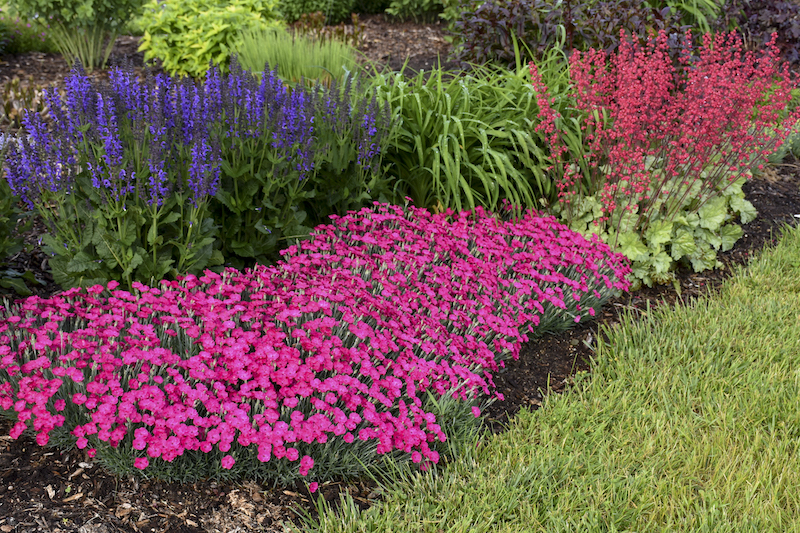
So, whether you want to create a charming cottage garden or a modern landscape, thoughtful selection and placement of Dianthus varieties are key to achieving a colorful and cohesive design.
Tips for Extending the Blooming Season
Extending the blooming season of your dianthus plants requires careful planning and proper maintenance. By implementing a few key strategies, you can enjoy the vibrant colors and delicate fragrance of these beautiful flowers for an extended period.
- Deadheading:
- Regularly remove faded and spent blooms.
- Redirects energy towards producing new buds.
- Promotes continuous blooming.
- Consistent Watering:
- Dianthus prefers well-draining soil.
- Avoid waterlogged conditions.
- Water consistently, allowing the top soil layer to dry slightly between waterings.
- Encourages healthy root growth and steady blossoms.
With these tips in mind, you can maximize the blooming season of your dianthus plants and enjoy their beauty and charm for an extended period. By maintaining proper care and diligently implementing these strategies, your garden will be adorned with stunning dianthus blooms throughout the growing season.
Common Mistakes to Avoid when Growing Dianthus
When it comes to growing Dianthus, there are a few common mistakes that you should avoid to ensure optimal growth and health of your plants.
lacks proper drainage
One mistake to steer clear of is planting Dianthus in soil that lacks proper drainage. These flowers prefer well-drained soil, so if the soil in your garden is heavy and prone to waterlogging, consider amending it with organic matter or planting Dianthus in raised beds or containers.
overwatering
Another mistake that can hinder the success of your Dianthus is overwatering. While these plants do require regular watering, too much water can lead to root rot and other fungal diseases. It’s important to strike the right balance by watering Dianthus thoroughly but allowing the soil to dry out slightly between waterings. Remember to also avoid overhead watering, as wetting the foliage can increase the risk of fungal infections. By providing the right amount of water, you can help your Dianthus thrive and avoid common pitfalls.
Troubleshooting Common Dianthus Issues
Dianthus is a popular flower among gardeners due to its vibrant blooms and delightful fragrance. However, like any plant, it may encounter certain issues that can hinder its growth and overall health.
- Powdery Mildew Management:
- Ensure adequate spacing between Dianthus plants to promote airflow and reduce humidity levels.
- Remove affected leaves promptly to prevent the spread of powdery mildew.
- Apply a fungicidal treatment to affected plants as a preventive measure against powdery mildew.
- Root Rot Prevention:
- Use well-draining soil to prevent water from pooling around the roots and causing rot.
- Monitor watering practices carefully, allowing the soil to dry out slightly between waterings.
- Remove any affected plant parts promptly to prevent the spread of root rot.
- Apply a fungicide to affected plant parts as a preventive measure against root rot.
By being aware of these common issues and taking proactive measures to prevent and address them, you can ensure the health and vitality of your Dianthus plants. With proper care and attention, your Dianthus garden will thrive, providing you with an array of beautiful blooms to enjoy.
Harvesting and Using Dianthus Blooms
When it comes to harvesting and using Dianthus blooms, timing is crucial. It’s best to wait until the flowers are fully open and at their peak before cutting them. This ensures that you get the most vibrant and long-lasting blooms for your arrangements or other uses. Avoid picking flowers that are still in bud form, as they may not fully open and may not last as long once cut.
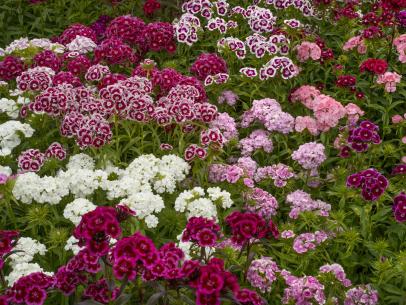
- Harvesting Dianthus Blooms:
- Gently grasp the stem just below the flower head.
- Cut at a slight angle using clean, sharp pruning shears or scissors.
- Remove excess foliage and buds from the stem.
- Place cut blooms immediately in a bucket of clean, cool water to keep them fresh.
- Uses for Dianthus Blooms:
- Floral Arrangements: Create stunning bouquets and centerpieces.
- Culinary Delights: Add petals to salads, desserts, or as garnish.
- Potpourri and Sachets: Their fragrant petals are perfect for scented sachets.
- Wreaths and Garlands: Use their vibrant colors and unique textures for whimsical decorations.
Dianthus blooms are also edible and can be used to garnish salads, desserts, and cocktails. So whether you’re looking to brighten up your home or add a little pizzazz to your next meal, Dianthus blooms are a versatile and beautiful option to consider.
Creating a Stunning Dianthus Flower Arrangement
When it comes to creating a stunning dianthus flower arrangement, there are a few key factors to keep in mind.

- Consider Color Scheme: Choose dianthus flowers in a range of hues to achieve your desired color scheme, whether it’s complementary colors or a monochromatic display, for a striking visual impact.
- Select Suitable Container: Opt for a vase or container that provides adequate support for the stems and showcases the beauty of the dianthus blooms. Clear glass or ceramic vases are popular choices, considering the size and shape in relation to the stems for balance.
- Prepare and Arrange Stems: Trim stems at an angle for better water absorption and remove submerged leaves to prevent decay. Arrange dianthus stems in varying heights and placements within the container for depth and dimension.
- Incorporate Complementary Elements: Enhance the arrangement with complementary flowers or foliage like baby’s breath, limonium, or eucalyptus to add interest and texture. Experiment with different combinations until achieving the desired effect, allowing creativity to guide the process.
Remember, a stunning dianthus flower arrangement is all about balance, color harmony, and showcasing the natural beauty of the blooms. By taking these factors into consideration and allowing your creativity to flourish, you’ll be able to create an eye-catching display that will enhance any space. Stay tuned for more tips and tricks on gardening and floral arrangements.
Watch video for more information:
FAQ
How do I choose the right varieties of Dianthus for my climate?
When selecting Dianthus varieties for your climate, consider the average temperature, humidity levels, and sunlight exposure in your area. Choose varieties that are known to thrive in your specific climate conditions.
What are the important factors to consider for Dianthus growing requirements?
Dianthus plants require well-draining soil, ample sunlight, and regular watering. They also prefer slightly alkaline soil with a pH level between 6.0 and 7.0.
What is the best way to prepare the soil for planting Dianthus?
Before planting Dianthus, it is essential to prepare the soil by removing weeds, loosening it with a garden fork, and adding organic matter such as compost to improve drainage and fertility.
Can you provide a step-by-step guide for planting Dianthus?
First, dig a hole slightly larger than the plant’s root ball. Place the Dianthus in the hole, ensuring the top of the root ball is level with the soil. Backfill the hole and gently firm the soil around the plant. Finally, water thoroughly.
How should I water Dianthus plants properly?
It is important to water Dianthus deeply but infrequently. Aim for one inch of water per week, either through rainfall or supplemental watering. Water at the base of the plant to avoid wetting the foliage, which can lead to disease.
What Are The Dos And Don’ts Of Fertilizing Dianthus?
Do fertilize Dianthus in early spring with a balanced slow-release fertilizer. Don’t over-fertilize, as it can lead to excessive foliage growth and reduced flowering.
How should I prune Dianthus for optimal growth?
To promote bushier growth and prolong blooming, pinch back the tips of Dianthus stems after the first flush of flowers has faded. Additionally, remove any dead or diseased foliage throughout the growing season.
How can I protect my Dianthus plants from pests and diseases?
Regularly inspect your Dianthus plants for signs of pests or diseases. Use appropriate organic or chemical remedies if necessary, and ensure good air circulation around the plants to prevent fungal diseases.
Can I divide and propagate Dianthus plants?
Yes, Dianthus can be divided to create new plants. Dig up the mature plant and carefully separate the clumps, ensuring each division has roots attached. Replant the divisions in well-prepared soil and water thoroughly.
What are the best companion plants for Dianthus?
Dianthus pairs well with plants like lavender, salvia, yarrow, and catmint. These companions not only complement the aesthetic of Dianthus but also provide similar growing conditions.
How can I create a colorful Dianthus garden design?
To create a vibrant Dianthus garden design, choose Dianthus varieties in a range of colors, including different shades of pink, white, red, and purple. Consider incorporating contrasting foliage plants for added visual interest.
Are there any tips for extending the blooming season of Dianthus?
Deadhead spent flowers regularly to encourage continuous blooming. Additionally, provide consistent moisture and avoid extreme temperature fluctuations to prolong the blooming season.
What are some common mistakes to avoid when growing Dianthus?
Avoid overwatering, planting in poorly-draining soil, neglecting to prune, or using excessive amounts of fertilizer. These common mistakes can hinder the growth and overall health of Dianthus plants.
How can I troubleshoot common issues with Dianthus plants?
If your Dianthus plants are not blooming or are wilting, consider factors such as insufficient sunlight, improper watering, poor soil drainage, or pest infestations. Addressing these issues can help resolve common problems.
Can Dianthus blooms be harvested and used in flower arrangements?
Yes, Dianthus blooms can be harvested and used in flower arrangements. Cut the stems just as the flowers begin to open fully and place them in a vase with water and floral preservative to extend their vase life.
How can I create a stunning Dianthus flower arrangement?
To create a stunning Dianthus flower arrangement, select a variety of Dianthus blooms in different colors and heights. Combine them with complementary foliage, such as ferns or eucalyptus, and arrange them in a vase with water, ensuring the stems are properly trimmed.

Studied Agricultural Engineering-Plant Protection at University of California, Davis.
Head of Content writing team at Southelmontehydroponics.com

